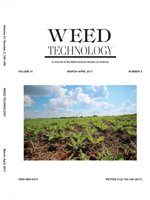Weed-free field experiments were conducted to evaluate soybean injury, growth, and yield following PRE or POST pyroxasulfone application. Soybean was injured 1 and 15% following pyroxasulfone PRE and POST application, respectively, 7 d after treatment (DAT). Injury following PRE and POST application was observed as delayed emergence and leaf necrosis and crinkling, respectively. Injury ranged from 0 to 6% following both application timings 14 and 28 DAT. Soybean was injured 5% or less following 60, 120, 180, 240, and 300 g ha-1 of pyroxasulfone. Soybean plant population, height, and yield were not affected by pyroxasulfone application timing. Only 300 g ha-1 of pyroxasulfone reduced soybean plant population to 90% of the nontreated 30 d after PRE. Pyroxasulfone rate did not influence soybean heights and yield. Data indicates that pyroxasulfone can safely be applied to soybean without a detrimental effect on plant growth or yield.
Nomenclature: Glyphosate; pyroxasulfone; soybean, Glycine max (L.) Merr.





